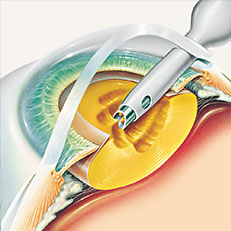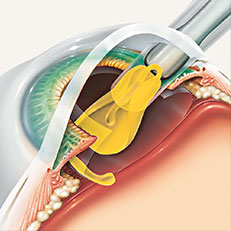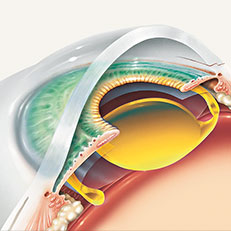Cataract surgery - One of the safest procedures in medicine
"Cataract" describes an opacity in the crystalline lens, which is transparent in healthy eyes. The cataract is characterized by a slow, painless reduction of vision. The affected cataract patient sees the environment through a fog accompanied with a strong increase in glare, especially during night driving. The most common cause for a cataract is age, as the cataract is a result of the aging processes of the lens. Cataract surgery, which is routinely performed about 20 times a week at IROC Zurich eye clinic, is one of the most frequently performed surgeries in medicine.
Every human experience cataract formation at some point in life. In some people it occurs as early as at the age of 45, and in others cataract disturbs the patient not earlier than an age of 80 years. This high variability of cataract formation may be partially explained by environmental factors like UV-light-exposition: "White-collar"-workers usually develop the cataract later in contrast to fishermen spending a lot of time outside develop the cataract earlier.
During the pre-examination prior to cataract surgery at IROC Zurich eye clinic, our ophthalmologists thoroughly investigate and measure the patient's eye dimensions with a high precision, and identify possible risks factors regarding the operation. Since the time point at which a patient needs cataract surgery is highly individual, we plan the surgery together with the patient in a detailed discussion after the pre-examination. In addition, the use of a femtosecondlaser might be advantageous and necessary in certain cases to further increase safety and precision of your cataract surgery.
In particular, ophthalmologists at IROC focus on the expectations and individual desires for the postoperative outcome of the patient. The aim of cataract surgery at IROC eye clinic consists not only of exchanging your opacified lens, it's also targeting on a spectacle-free future after cataract surgery. IROC cataract surgeons are using most modern surgical techniques as well as latest intraocular aspheric, toric and multifocal lenses to guarantee the best-possible outcome. In cases in which toric and multifocal lenses were implanted we offer a cost-free refractive laser correction after the surgery if the initial result is not good enough to ensure spectacle-free vision.
Cataract treatment procedure & healing process
Cataract operation usually requires local anesthesia, either by means of local injection of anesthetics or by using topically applied anesthetic eye drops. Alternatively, general anesthesia may be performed in rare cases. The entire cataract operation takes about 25 minutes and is performed under a surgical microscope. Latest scanning laser systems are assisting our ophthalmologists during cataract surgery in order to identify and prevent intraoperative complications and to place the new lens at the optimal location inside the patient's eye. The risks of the cataract operation are reduced to a minimum by a detailed and precise pre-examination, the long experience of IROC cataract surgeons, and the femtosecond laser.
The total time, that a patient scheduled for cataract surgery spends at IROC, is about 3 hours per eye. Risks for cataract operation are reduced to a minimum with a detailed and precise pre-examination and the long experience of IROC cataract surgeons.
Pictures 1 to 3 illustrate schematically how cataract surgery at the IROC eye clinic is performed by our eye specialists.
Picture 1: Lens extraction
By a less than 2.5 mm wide incision, the eye is opened and anterior lens capsule is removed. This transparent lens capsule is only a few thousands of a millimeter thick and the remaining capsular bag serves as a holding device for the new artificial lens. Subsequently, the opacified lens (cataract) is aspirated by means of an ultrasound pencil. When using the femtosecondlaser, both capsule opening and lens fragmentation are performed with high precision.
Picture 2: Implantation of a new lens
In the next step, the new artificial lens (aspheric, toric or multifocal) is implanted. The artificial lens is folded by the surgeon, and inserted through the narrow tunnel into the capsular bag. The wound usually does not have to be sutured, as the incision opening is very small (less than 3 mm) and designed for self-sealing after surgery.
Picture 3: Termination of the cataract surgery
The artificial lens is unfolded and placed in the capsular bag. It is held in place by flexible haptics and is now in exactly the same location as the natural eye lens that was removed.
During the recovery process, a reduction in vision may occur within the first days. Typically, a week is necessary for the patient to return to normal daily activities after the cataract surgery. Only after the successful visual rehabilitation of the first eye, we perform surgery in the second eye which is usually the case after one week. Postoperative consultations with IROC ophthalmologists are scheduled at 1 day, 1 week and 1 months after the cataract surgery. If an appointment is necessary in between, we are always at your convenience. If you have any symptoms that appear abnormal, we are ready for a same-day emergency consultation at IROC. During the postoperative course we encourage you to use the prescribed eye drops in the recommended scheme to support your eye's healing process in an optimal way.
Get more information about cataract surgery in our Q/A section.




